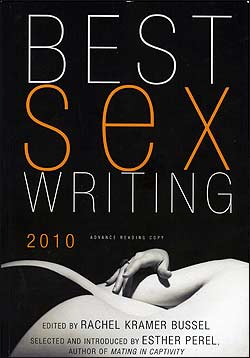
Sexting, Swinging and Getting Vulnerable
Best Sex Writing 2010 covers ground both familiar and new
by Suzi Steffen
 |
Looking for hot literary tales of sexual derring-do? For the most part, that’s not what you’ll find in Best Sex Writing 2010, as series editor Rachel Kramer Bussel reminds readers in her introduction. Though a few of the reprinted pieces (including that of local author Michelle Perrot) contain fiery passages, many of the essays fire up a different portion of the human emotional range, including humor, analytical precison and fury.
The fury comes in specifically in one of the strongest non-personal pieces, Judith Levine’s brilliant “What’s the Matter with Teen Sexting?” Hey! That’s a great damn question! Why are (some) adults so freaked out about teen sexuality? How could anyone prosecute kids as sex offenders for sending nude photos of themselves to their friends or partners?
Well, perhaps it’s because they never read Thomas MacAulay Millar’s “Toward a Performance Model of Sex,” which takes the women’s sexuality=cow milk equivalence and knocks it back into the Pandora’s box of misogyny. Admittedly, Millar’s is a long, meandering, top-heavy argument that spends too long with the buildup and not enough time at the climax, but combined with Ellen Friedrichs’ “Sex Laws That Can Really Screw You,” the essay provides a powerful backing for reconceptualizing sexual agency.
In between these more reported, factual pieces come the first-person experience snippets. Some of these, like Perrot’s, are both literary and erotic; some of them, like Diana Joseph’s “The Girl Who Only Sometimes Said No” and Kirk Read’s “It’s a Shame About Ray,” contain moving portraits of their writers or the people closest to them. Joseph’s piece in particular illustrates sensitive, painful clashes between parent and child, between different conceptualizations of female sexuality, between the mom’s experiences of a sexual life and the junior-high-aged son’s callous dismissal of girls’ ability to define themselves. “The Girl Who Only Sometimes Said No” leads the book, and it’s gorgeous; few of the following pieces live up to its promise, and some are flat-out poorly written even if the information contained in them has value in a society that doesn’t really understand how to talk about sex and sexuality.
Some articles end a bit short, finished before readers can be satisfied, like Chris Hall’s “Lust and Lechery in Eight Pages: The Story of the Tijuana Bibles” (more information, please!), and some labor on without much reward. Still, they’re forays into areas many people don’t get to talk about enough, if at all. Seth Michael Donsky’s mostly strong “The Trouble with Safe Sex” brings up the alarming rise in numbers of HIV-positive young gay men and talks about new ways to market self-care and honesty to guys who want to bareback.
I had to put the book down for a ranty break in the middle of William Georgiades’ cocktastic “Loving Lesbians” (He doesn’t). Then there’s David Black’s goofily Disney-like portrait of swinger-land (“Hot. Digital. Sexual. Underground.”). Yay for swingers, yay for polyamory, yay for all non-nonconsensually-abusive human experience with sex, but Black makes the entire thing sound so simplistic and shiny that emotions disappear from the page.
Still, as with any anthology, your mileage will vary. Best when it’s most honest and human, when the writers explore the nooks and crannies of our most potent sex organ, the brain, with skill and a juicy mix of enjoyment, danger, taboo and honest lust, Best Sex Writing 2010 belongs on the nightstand of any sexual being who can read, think and express desire.
Best Sex Writing series editor Rachel Kramer Bussel and contributors Janet Hardy and Michelle Perrot read at 6 pm Sunday, Feb. 21, at Tsunami Books. Free.
The Haunted, Historical West
Alyson Hagy, a transplant from Blue Ridge Mountains of Virginia to the vast ranges of Wyoming, mixes the detachment of an outsider with an insider’s understanding of the historical controversies of the West in her short story collection Ghosts of Wyoming (Graywolf Press, $15). In Hagy’s stark and spare prose, activists bump heads with ranchers while a family drama swirls beneath the surface; an ailing government official converges with headstrong mountain climbers on a sacred Native American site; and a grad student deals with a library ghost. The stories, from frontier days to the present day, capture a ghostly sense of the American West. — Camilla Mortensen